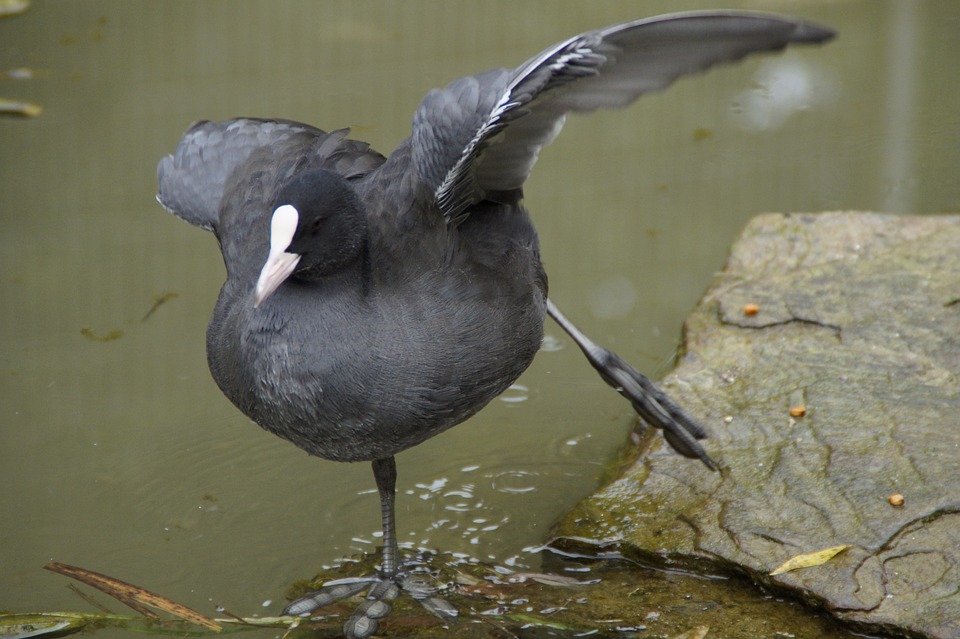American coot
(Fulica americana)

Description
Fulica americana, commonly known as the American coot, is a unique and fascinating bird species found throughout much of North America. In this article, we will explore the various aspects of the American coot's taxonomy, distribution, habitat, behavior, diet, and conservation status. Taxonomy: The American coot is a member of the family Rallidae, which includes other waterbirds such as rails, gallinules, and crakes. Its scientific name is Fulica americana, with "Fulica" being a Latin word meaning "coot," and "americana" indicating its origin in North America. The American coot is a medium-sized bird, with a body length of around 13-16 inches and a wingspan of approximately 23-25 inches. It has a distinctive appearance, with dark gray feathers, a white bill, and bright red eyes. Distribution and Habitat: The American coot is found throughout much of North America, including Alaska, Canada, the United States, Mexico, and parts of the Caribbean. It is a migratory bird species that will travel to different locations depending on the season. In terms of habitat, the American coot is typically found in freshwater wetlands such as ponds, lakes, marshes, and swamps. It prefers shallow water with abundant vegetation and cover, which provides both food and shelter. The American coot can also be found in brackish water habitats such as estuaries, tidal marshes, and coastal lagoons. During the non-breeding season, American coots may also be found in open waters such as reservoirs and rivers. Overall, the American coot is a highly adaptable bird that can survive in a variety of aquatic environments, as long as it has access to food and shelter. Behavior: The American coot is a social bird that is often found in large groups known as "rafts." It is a strong swimmer and diver, and can often be seen paddling around in the water using its feet to propel itself forward. It is also capable of flying, although it prefers to stay close to the water's surface. During the breeding season, male American coots will establish territories and perform courtship displays to attract females. The female will then build a nest on the water's edge, using reeds, grasses, and other plant material. Both parents will then take turns incubating the eggs and caring for the young. Diet: The American coot is an omnivorous bird species that feeds on a variety of plant and animal material. Its diet includes aquatic plants, algae, seeds, insects, crustaceans, mollusks, and small fish. It is also known to scavenge on carrion and will sometimes steal food from other birds. The American coot uses its specialized bill to forage for food in shallow water, by either wading or diving underwater. It will also swim on the surface of the water and use its feet to stir up food from the bottom. During the breeding season, the American coot will also bring food to its young, which are initially fed a diet of insects and other small invertebrates before transitioning to a diet of plants and larger invertebrates. Overall, the American coot's omnivorous diet allows it to thrive in a variety of aquatic habitats, where it can take advantage of different food sources depending on availability. Conservation Status: The American coot is considered a species of least concern by the International Union for Conservation of Nature (IUCN). Its population is believed to be stable, and it is not currently facing any significant threats. However, like many waterbird species, the American coot is vulnerable to habitat loss and degradation caused by human activities such as agriculture, urbanization, and pollution. Wetland destruction and alteration, in particular, have been identified as major threats to American coot populations. Wetlands are essential habitats for the American coot, providing both food and shelter, and their loss can have significant impacts on the species. Conservation efforts aimed at protecting and restoring wetland habitats are therefore critical to ensuring the continued survival of the American coot. In addition, monitoring of American coot populations and research on their ecology and behavior can provide valuable information for conservation planning and management. Although the American coot is currently not considered to be at high risk of extinction, continued conservation efforts will be necessary to maintain its populations and ensure its long-term survival. Conclusion: In summary, the American coot is a unique and fascinating bird species that is found throughout much of North America. It is well adapted to life in freshwater wetlands, where it feeds on a wide variety of plant and animal material. While it is not currently facing any significant threats, its habitat is vulnerable to degradation and loss, making conservation efforts crucial to ensuring the continued survival of this species.
Taxonomic tree:







